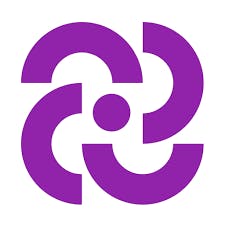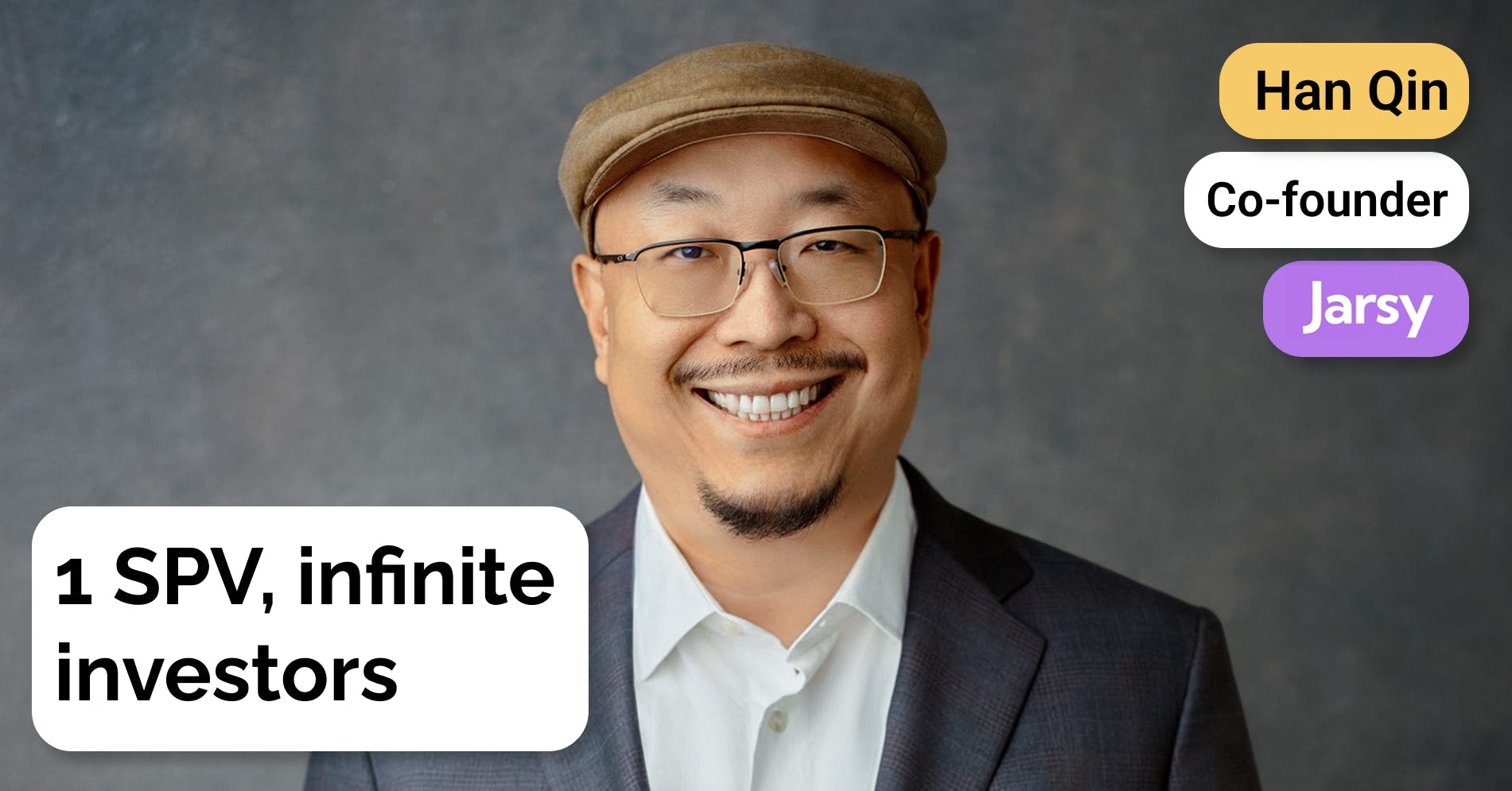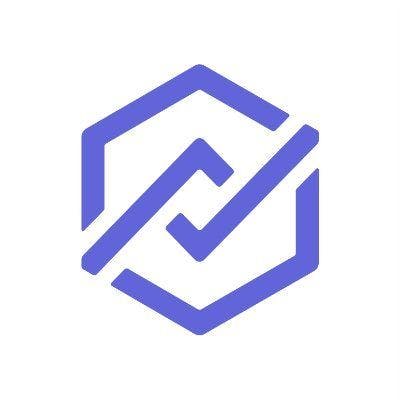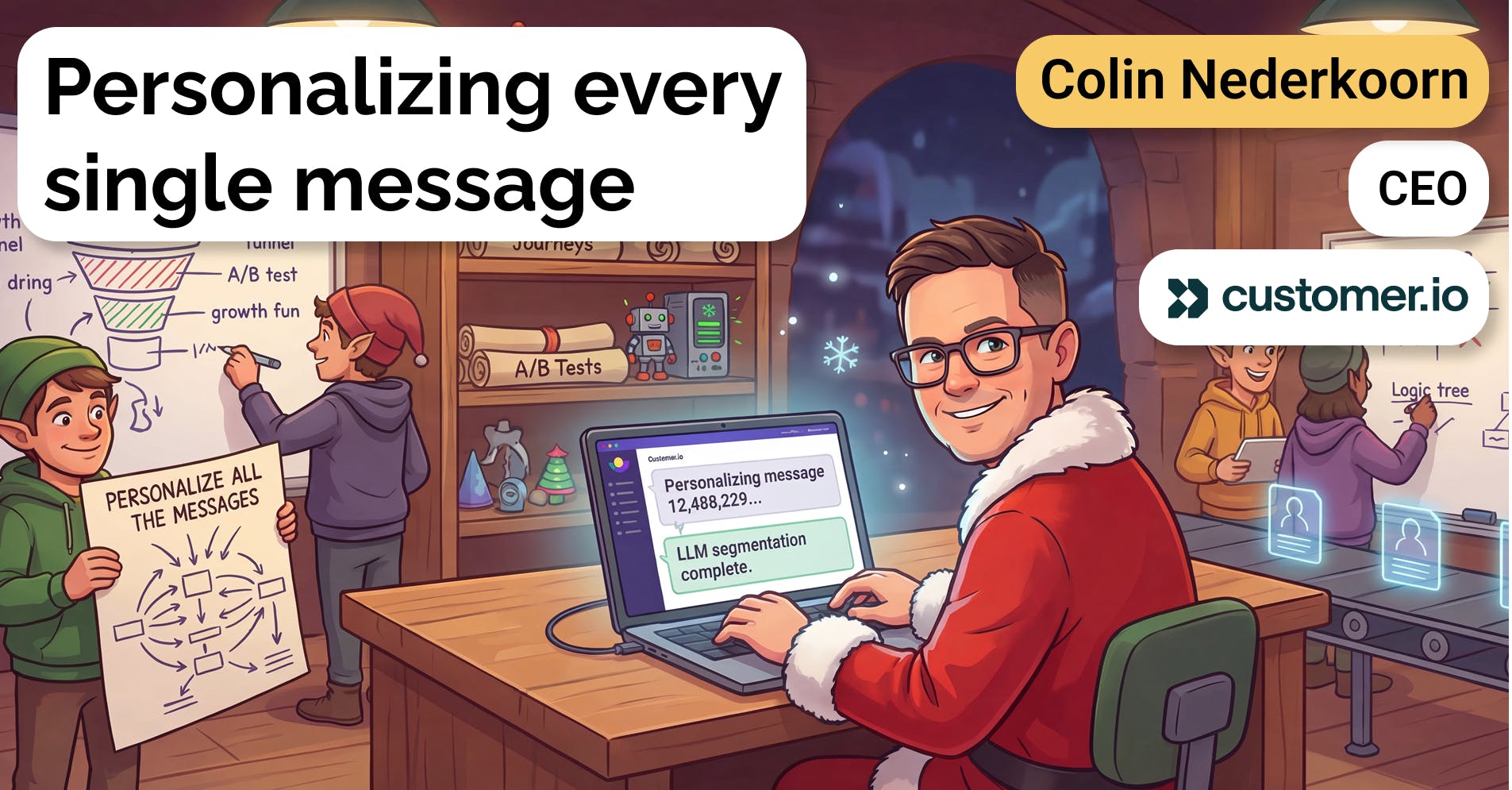Ben Haber, CEO of Monark, on building the DTCC for the private markets
 Jan-Erik Asplund
Jan-Erik Asplund
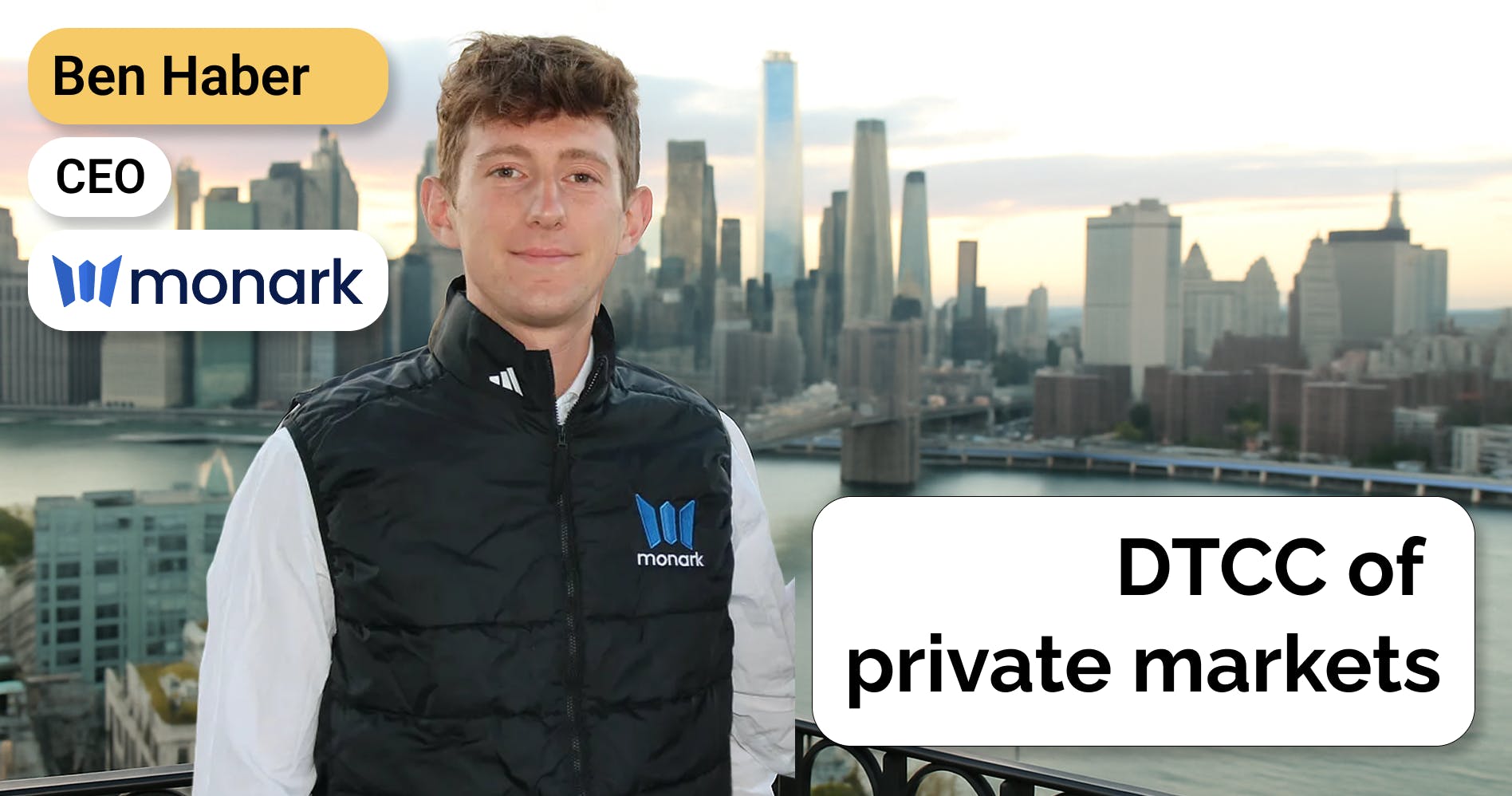
Background
Schwab, SoFi, and Robinhood have all added pre-IPO stocks, private equity, and other private alternatives to their investment platforms over the last year.
To better understand the pipes behind that shift, we reached out to Ben Haber, co-founder & CEO of Monark ($2.2M seed round, Garuda Ventures), a B2B API that helps brokerages, clearing firms, and others launch private asset trading.
Key points via Sacra AI:
- When Robinhood (founded 2012) popularized zero-commission stock trading funded by payment-for-order-flow (PFOF), it pushed Schwab, Fidelity, and TD Ameritrade to give up their lucrative $5-10 per-trade stock commissions—today, private alternative assets like pre-IPO stocks, private equity funds & real estate give brokerages a new source of high-margin, 2-3% commission revenue. "The ability for a brokerage partner to make 2-3% commission on dollars raised for a private security versus maybe 1/100th of that or less for payment for order flow, for the same dollar volume of dollars invested through their platform, is obviously a very significant difference. . . If we can be the highest margin business line for our clients, we become a really sticky product that they're going to want to continue investing time, resources, UX/UI, etc. into."
- Alternative asset infrastructure companies for pre-IPO (Monark, Zanbato), private credit (iCapital), and crypto (Alpaca) are selling 1) into brokerage-as-a-service providers like ViewTrade as white-labeled APIs, and 2) as product features directly integrated into consumer-facing brokerages & wealth management apps like SoFi and eToro. “The nucleus of the market is DTCC, the Depository Trust and Clearing Corporation. . . built on top of DTCC are all the clearing firms—Pershing, Fidelity, Schwab, Apex Clearing, Drivewealth, Altruist serving another layer of clients, which are either your self-directed brokerage platforms or your Registered Investment Advisors. . . In terms of Monark's role, we are continuing to partner with retail brokerage platforms, clearing firms, wealth management firms, providing access to more private asset classes through our APIs. At a certain point, I think Monark starts to look like the DTCC of private markets.”
- With $14 trillion in new AUM potentially unlocked by Trump's August 2025 executive order paving the way for 401(k) plans to include crypto & other private assets, Schwab, SoFi, and Robinhood are preparing to bundle up pre-IPO stock and other alternative assets onto their platforms to maximize wallet share. "What we're noticing on the public retail brokerage side is that Robinhood, SoFi, eToro, etc., are adding as many product lines as they can—IRA accounts, event contracts, fixed income trading, crypto trading, public equities, options, futures. They're trying to bring the whole world of financial markets within one platform."
Questions
- What is Monark in short? What was the founding insight and how did you get inspired to start it?
- Going into the history of companies that have tried to build D2C alt investing platforms, can you say more about the problems you observed?
- If an app like Robinhood or a neobank wants to spin up private‑stock trading, walk us through the end‑to‑end flow of how they get set up with Monark.
- What would you say are some of the key challenges?
- In terms of general education around Pre-IPO companies, how has that changed? What alternative assets do you find have the biggest pull from the market, and where are Pre-IPO companies in that? Is that growing significantly in terms of customer recognition and demand?
- Can you run us through the economics for the end user, Monark customers and Monark?
- What’s the flow of funds and chain of custody for the underlying assets look like?
- Can you talk about how you ramp up the supply side of deals & SPVs to meet Monark customer demand?
- How do you map out the market for investing and wealth management platforms, from robo-advisors like Wealthfront, to trading apps like Robinhood, to tax optimization products like AltoIRA and others?
- How has the advent of 0% commissions and the payment for order flow business model changed the business models of brokerages and wealth platforms?
- There’s been a lot of talk recently about tokenized private stock—Robinhood, Republic, PreStocks. What do you make of this trend? Do you see tokenized private stock being a reality and for what kinds of use cases?
- What are the biggest bottlenecks to unlocking more liquidity in private markets? Is it cap table friction, company willingness, seller supply, or something else? And what do you see as the most important unlock in the next few years?
- If everything goes right for Monark over the next five years, what does it become and how is the world different?
Interview
What is Monark in short? What was the founding insight and how did you get inspired to start it?
At a high level, Monark is a B2B API infrastructure platform that enables retail brokerages and wealth management firms to provide access to private markets. We cover everything from pre-trade investor suitability to trade processing to post-trade reporting and secondary trading.
Paul and I started Monark when we were both students at NYU. The founding insight was that we saw a lot of attempts at creating direct-to-consumer alternative investment platforms, but we didn't see any of those companies really reaching scale. A lot of those companies, including the LEX Markets platform that we acquired, were either going bankrupt, shutting down, or getting acquired.
We realized that clearly there's retail demand to invest in private securities and private markets, but the direct-to-consumer format for doing so is not the most effective way to reach scale. Our founding insight was recognizing that B2B distribution of private securities or alternative investments through existing brokerage and wealth management channels was a much more effective way of reaching critical distribution scale. That's the foundational thesis behind what we're building at Monark.
Going into the history of companies that have tried to build D2C alt investing platforms, can you say more about the problems you observed?
Fintech customer acquisition costs are historically very high. That's true in the retail public brokerage market as well as the alts space. Just getting customer eyeballs on your platform is an expensive challenge that definitely hinders a lot of platforms from scaling.
As a result, many platforms that are direct-to-investor pivoted towards the higher net worth investor segment. If you're going to pay a high customer acquisition cost anyway, you might as well go after investors with the biggest wallet size who can invest more dollars through your platform. As a result, a lot of platforms that were claiming to democratize access to different private asset classes were actually pivoting higher up market rather than going further down market to reach more retail investors. Some platforms even pivoted to serve institutional investors only instead of retail.
The other result of not reaching scale as a platform in the private markets is that you're often not able to get access to the best quality assets. That adverse selection bias becomes very apparent across many direct-to-consumer alternative investment platforms.
One other point: for retail investors, the idea of having multiple platforms to access financial markets creates more burden versus having access to all of your investments within a single platform experience. What we're noticing on the public retail brokerage side is that Robinhood, SoFi, eToro, etc., are adding as many product lines as they can—IRA accounts, event contracts, fixed income trading, crypto trading, public equities, options, futures. They're trying to bring the whole world of financial markets within one platform. We think that should also be true for private investing—that it should be within that same platform where investors can access the rest of financial markets.
If an app like Robinhood or a neobank wants to spin up private‑stock trading, walk us through the end‑to‑end flow of how they get set up with Monark.
Monark's product covers both the primary issuance of private assets as well as secondary trading of private securities. We try to be the one-stop shop for our clients to access all of private markets through our API infrastructure.
In practice, if a retail brokerage firm or wealth management platform wants to work with Monark, the first step is our API integration that integrates directly within their existing platform, powering their front-end user experience as well as the back-office connectivity to help facilitate trades, money movement, position reporting, and secondary trading. It's a full integration with the existing brokerage platform or wealth management platform's infrastructure, all via API.
Separate from that, we provide compliance and marketing support, helping our clients understand private markets in general and some of the specific compliance requirements around offering access to private securities. We've been very hands-on with our clients, in particular because many retail brokerage and wealth management platforms don't have a very good view into private markets today and have leaned on us pretty heavily to really understand the opportunities as well as the challenges in providing access to private markets.
What would you say are some of the key challenges?
Private securities are offered under a different regulatory framework that most public brokerage or wealth management platforms aren't used to navigating. For example, Reg D offerings, Reg S offerings for international investors—that's not something you typically see on a traditional retail brokerage. Even just understanding what the regulations are, what investor qualifications are required to allow access to these products, what reporting requirements are required with FINRA or the SEC.
There's also general education around what is a Pre-IPO company, why do investors want to access Pre-IPO companies, what is a tender offer fund or an interval fund, what is a BDC. How should platforms be marketing or framing these types of investment products to their investors? What are the advantages? What are the disadvantages? How does liquidity work within private markets? What are the custody requirements? Some of the questions that you sent over are the very same questions that our clients are asking us as they navigate adding private markets to their platform.
In terms of general education around Pre-IPO companies, how has that changed? What alternative assets do you find have the biggest pull from the market, and where are Pre-IPO companies in that? Is that growing significantly in terms of customer recognition and demand?
Pre-IPO has actually been very much our wedge product for many of the clients that we've started working with, both in the sales process between Monark and our B2B partners, but also in terms of the launch and activation process that our brokerage partners go through with their end investors.
Honing in on the idea that brand is what sells is the right starting point. What that means in practice is brands like SpaceX, OpenAI, Anthropic—that's what retail investors are excited about when they think about private markets. That's what they're interested in investing in. So it's a great starting point in terms of launching private market access on a new platform to start with the brands that investors are already interested in and looking to invest in.
We've seen that in practice, both in terms of starting with our partners by launching names like SpaceX or Stripe. Some of our partners have run surveys with their clients to understand what types of alternative investments their clients are interested in—Pre-IPO has been a resounding response, particularly the top five to ten names within the Pre-IPO space. There's even a search history that one of our clients shared with us where one of the top names that their investors were looking for in the general search bar was SpaceX.
There's a lot of top-of-market demand that makes it a great starting point for platforms as they launch access to private markets in general. Over time, there will be more retail investor demand for some of the diversified products as well—thinking more like a Blackstone Evergreen Fund or a KKR fund or an Apollo fund. From an operational perspective, those funds are constantly raising capital, so it makes it easier to make one of those funds available on a brokerage platform and allow investors to invest really at any time. Those are also a really good way for retail investors to gain exposure to private markets if they don't know what specific single asset names they want to invest in.
We've started adding the registered fund product line to our API product, so partners that we're already working with to provide access to the Pre-IPO market can also start to add some of these registered alternative investment funds as well.
For the end investor, it's similar to the mutual fund space, both for the registered products as well as the Pre-IPO products. They're effectively paying a one-time upfront management fee that gets deducted from the total investment amount. So let's say they invest $100,000 and there's a one-time upfront 5% management fee. That management fee gets deducted from that $100,000, so $95,000 gets allocated to the underlying investment that the SPV is holding.
That also holds true for the registered funds—Blackstone, KKR, etc. The way they charge for access to their evergreen products is they'll add a sales load, typically around 3.5%, that is paid out to the broker-dealer’s that are distributing the fund. So that is generally what the end investor is paying—basically a commission or upfront management fee to access these products. In our model, it's only ever a one-time fee. There are no ongoing management fees and rarely carried interest on the investments that we offer.
The way we revenue share with our B2B partners is a commission sharing model where we'll split those commissions with our brokerage partners, typically 50-50, but that can vary depending on the partner. Let's say there's a 5% management fee—we'll pay off the admin expenses for the SPV and then we'll split that remaining 4.5% or whatever is remaining after the admin expenses between Monark and our brokerage partner(s).
Separately, we have entered into a technology API licensing contract with one of our clients that serves fee-only RIAs. RIAs are their only customer segment and they don't serve any self-directed retail investors. The reason we put together a licensing contract for that partner is because the advisor share class that they're offering access to cannot charge a sales load or commission because it's a fee-only advisor platform. Those advisors have a fiduciary responsibility to get the best point of access for their investors. There are specific share classes that the evergreen funds will create for fee-only advisors that don't have that sales load, and because there is no commission revenue for us to split or participate in, but we still want to support this client, we put together a technology licensing model as opposed to splitting commissions.
Generally speaking, for a retail brokerage partner where there is a commission revenue opportunity, we're sharing in that commission revenue.
What’s the flow of funds and chain of custody for the underlying assets look like?
One of the unique aspects of the Monark product is that when investors are investing in private investments powered by Monark's APIs, they are not required to go through a new account opening process. What we've been able to figure out, integrating with our partners, is actually how to enable investors to invest in these products directly from the cash balance in their existing brokerage accounts. This makes the end investor experience a lot easier.
If you have $10,000 sitting in your ViewTrade brokerage account or your Vested brokerage account, you can click a few buttons and invest directly in private securities offerings. All the money movement happens on the back end of that process, abstracted away from the end investor. It definitely makes the end investor experience a lot easier, especially not having to go through a new account onboarding or setup just to invest in private securities.
On the back end, we work with our brokerage partners or wealth management firms to facilitate the money movement from the investor's brokerage account out to the issuer of the SPV or the fund, making sure that we're running reconciliation processes with our partners on the distribution side as well as the issuer on the supply side, to ensure that all the funds and subscriptions match and are lined up.
In terms of custody, we've actually executed on two different models. The way probably 99.9% of private markets work today is under an issuer self-custody model, where the issuer is actually managing the cap table of investors and issuing either a digital share certificate or a tracking on a ledger a record for investors as to what their holdings are. We've executed on that model with a few of our brokerage partners, where the issuer of the SPV or the fund is maintaining the books and records of the investor's positions. The asset itself is actually held off of the broker-dealer distribution partner's books. It's held away. That's the traditional model that has historically been the case for really any broker-dealer participating in a private placement offering.
But what we're also executing on with two of our clearing firm partners is the concept that the clearing firm itself is actually the custodian of the client's assets. An investor can invest in a Pre-IPO SPV and then that SPV interest is actually held under custody with their clearing firm. It's reported on their brokerage statement. The NAV or valuation of the investment position is reflected directly in their account balance. It creates that user experience where the entire investment process, pre—and post-trade, is all reported in that same account.
In the issuer self-custody model, we're still able to show investors what their holdings are and roughly what they're worth based on third-party data sources, but it's a step away from that ideal experience where the asset is actually held under custody with their clearing firm.
Can you talk about how you ramp up the supply side of deals & SPVs to meet Monark customer demand?
Scale definitely matters a lot when you think about retail access to private markets. To your point earlier, issuers and funds want to know that if they're working with Monark or connecting into our network, they are really tapping into a broad distribution network.
Historically, for direct-to-consumer alternative investment platforms, that hasn't been the case. They've had this chicken-or-egg problem where they are trying to scale customer acquisition by getting more investors to sign up for their platform, while simultaneously trying to convince issuers to list their best investment products on their platform. There have been numerous attempts at doing that. Some have been moderately successful, but without that existing scale, it is really hard to solve both sides of the marketplace problem simultaneously.
We were very intentional about building a B2B product that taps into existing distribution networks. We don't take on retail investors directly. Monark has no direct-to-consumer platform. We really only serve investors through their existing wealth management or brokerage apps. That allows us to focus on market infrastructure and tap into a much broader scale of distribution, which then allows us to turn around and have much more compelling conversations with issuers, whether it's SPVs or private or registered funds.
On the supply side of the market, our pitch to them is not "sign up to list your product on Monark's platform." It's "sign up to list your product through Monark on a number of different brokerage and wealth management platforms." Scale definitely does matter in that equation.
How do you map out the market for investing and wealth management platforms, from robo-advisors like Wealthfront, to trading apps like Robinhood, to tax optimization products like AltoIRA and others?
Perhaps I'm a little unfair about how I categorize it, because I really lump all of the alternative investment platforms into one category. That would include Yieldstreet, Crowdstreet, even a Forge. Those platforms I see as providing direct-to-consumer access to private markets, whether it's one asset class or in some cases, like with Yieldstreet, multiple private asset classes. But that's almost a different category of the market relative to the traditional retail brokerage and wealth management platforms that we partner with.
Within the traditional space, really the nucleus of that market is DTCC, the Depository Trust and Clearing Corporation. They sit in the middle of really all public market activity, and they're basically the central clearinghouse for US public markets, at least on the equity side.
Built on top of DTCC are all the clearing firms—Pershing, Fidelity, Schwab, Apex Clearing, Drivewealth, Altruist. Those firms are really providing the clearing function for their clients. Typically, those clearing firms are then serving another layer of clients, which are either your self-directed brokerage platforms or your Registered Investment Advisors.
There are a number of different technology platforms that are layered in there. Obviously, firms like Apex and Altruist build their own technology natively. Other firms like Pershing or Schwab may license technology from other vendors. That creates that B2B layer on top of the clearing firms, and then the end investors come on top of that layer. So that's either self-directed retail investors or investors that are investing through their advisors. That's really how we think about the public market landscape of platforms and wealth managers that we serve.
How has the advent of 0% commissions and the payment for order flow business model changed the business models of brokerages and wealth platforms?
It's a function of really stiff competition within the traditional retail brokerage and wealth management space. Obviously, Robinhood introduced the payment for order flow model, and then every brokerage from Schwab and Fidelity down had to react to that and change their model accordingly. What that meant is it really wiped out commission trading for all of these platforms and really did drive down revenue for a lot of these platforms.
What makes private markets so compelling for a lot of these brokerages and wealth management platforms is the opportunity to reintroduce commissions. One of the big points of feedback and excitement that we're getting from our clients is that 5% upfront fee that we talked about before. The ability for a brokerage partner to make 2-3% commission on dollars raised for a private security versus maybe 1/100th of that or less for payment for order flow, for the same dollar volume of dollars invested through their platform, is obviously a very significant difference.
This is one of the more compelling aspects of providing access to private markets for a lot of the traditional retail brokerage firms and wealth management platforms. We see that as a huge advantage for Monark. If we can be the highest margin business line for our clients, we become a really sticky product that they're going to want to continue investing time, resources, UX/UI, etc. into.
There’s been a lot of talk recently about tokenized private stock—Robinhood, Republic, PreStocks. What do you make of this trend? Do you see tokenized private stock being a reality and for what kinds of use cases?
I had a conversation earlier this week with one of the larger stablecoin networks. They were thinking about the same thing, trying to understand how to get involved in both tokenized public equities and private securities as well. Interestingly enough, we actually shared the same perspective, so even with a stablecoin provider, they were on the same page as the perspective that we have.
Look, there will be a universe of companies and funds that issue direct tokenized equity to investors as a way for investors to access or invest in their products. That market will be niche. I do not think that will replace existing capital market infrastructure.
The reason for that is that capital market infrastructure, the model that's built around DTCC and all the clearing houses, are not incentivized to adopt a decentralized model for issuing and trading equity. They are incentivized as a function of their business to maintain the existing centralized model that exists for custody and clearing, which does reduce systemic risk. All the clearing firms have deposits that they put up with DTCC. All of their introducing broker clients have deposits that they put up with the clearing firm. The point of those deposits is to help alleviate and be able to remedy systemic risk when things happen throughout the ecosystem. Centralizing that and maintaining the centrality of that market infrastructure is very important and creates a dis-incentive for any of these firms to really try to broadly replace the existing infrastructure.
So I do think tokenization will exist as a niche market. I don't think it will replace existing infrastructure. I also think that firms that are tokenizing existing Pre-IPO SPV interests in particular—it really is not adding much value to the end consumer. If you could convince OpenAI to issue tokenized equity in OpenAI, that would be one thing. That's what the niche tokenization market will look like. However, companies that do choose to tokenize their equity directly will probably be companies that are struggling to raise capital in traditional private markets. For the time being, that can mature and get better. But it's similar, actually, to what we saw in the Reg A+ market in that the issuers that are really interested in doing Reg A+ offerings tend to be the issuers that can't get access to capital from the best VCs or the traditional routes of raising private capital.
But the platforms in particular that are adding a tokenized wrapper on top of an SPV structure are just adding additional layers of risk to the system, which I don't think is really a net benefit for the end investor or the existing capital market ecosystem as it stands today.
What are the biggest bottlenecks to unlocking more liquidity in private markets? Is it cap table friction, company willingness, seller supply, or something else? And what do you see as the most important unlock in the next few years?
We're actually really excited about this because probably the biggest bottleneck is the investor cap on SPVs right now. For most secondary SPVs, which is where a lot of the market activity is happening in the Pre-IPO space, SPVs are capped at 99 investors per vehicle. Issuers are limited in terms of how many SPVs they can issue in the same underlying asset, which means that minimums tend to be higher, and that excludes people that can't afford even the $25,000 investment from actually accessing some of these Pre-IPO companies. In many cases, that minimum is obviously much higher than $25,000. It could be in the hundreds of thousands.
We've tried really hard and will continue to work to provide access at lower minimums, closer to $10,000 as a minimum investment size. But even that has been challenging given the current constraints that the 99 investor cap creates.
There are two bills being discussed in the House right now that would both expand the definition of a qualifying venture capital fund to include secondary investments and fund-to-fund investments, as well as expand the number of investors that can participate in a qualifying venture capital fund to 2,000 investors per fund or per SPV. That will really blow the doors open in terms of the number of investors at lower minimums that can participate in the Pre-IPO market in particular.
If everything goes right for Monark over the next five years, what does it become and how is the world different?
The vision we have and that we're really starting to realize as we see it in action is five years from now, anyone can open their existing retail brokerage app or wealth management platform and invest in a wide variety of private investment opportunities, from Pre-IPO to registered investment funds, all the way to fractional real estate, music royalties, etc. That's what the future looks like, and we're already paving the path to get there, which is exciting.
In terms of Monark's role in that workflow, we want to be the infrastructure that powers that change that we want to see in the world. What that looks like is continuing to partner with retail brokerage platforms, clearing firms, wealth management firms, providing access to more private asset classes through our APIs, helping reduce as much systemic risk as we can throughout the process, and really continuing to scale our distribution network and our supply network to realize the vision of the B2B marketplace that we think needs to exist.
At a certain point, I think Monark starts to look like the DTCC of private markets. That's a tagline or phrase that we've used in the past. We're still a ways away from that, but ultimately, maybe five to ten years from now, that's really what this thing looks like.
Disclaimers
This transcript is for information purposes only and does not constitute advice of any type or trade recommendation and should not form the basis of any investment decision. Sacra accepts no liability for the transcript or for any errors, omissions or inaccuracies in respect of it. The views of the experts expressed in the transcript are those of the experts and they are not endorsed by, nor do they represent the opinion of Sacra. Sacra reserves all copyright, intellectual property rights in the transcript. Any modification, copying, displaying, distributing, transmitting, publishing, licensing, creating derivative works from, or selling any transcript is strictly prohibited.

